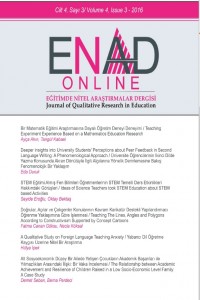Abstract
Affective constructs such as motivation, self-esteem, and anxiety play an important role in learning a foreign language. Scholars have conducted many studies to find out how these constructs affect foreign language (FL) learning. They aimed to find out how anxiety affects language learning, the sources of anxiety in FL learners, and how to overcome this anxiety. Teachers were offered various strategies to lower their students’ anxiety. Studies on Foreign Language (FL) anxiety mostly focused on the language learner. However, few studies investigated the anxiety experienced by teachers of English as a foreign language (EFL). This study aimed to investigate the factors that create anxiety in non-native EFL teachers while teaching the target language, English. Qualitative research design was used in this study. Data were collected through diaries and semi-structured interviews from 32 non-native EFL teachers. The data were analyzed manually using the content analysis technique. The results showed in which situations EFL teachers felt anxiety while teaching the target language. The analysis of the data resulted in 5 categories that can be sources of anxiety for EFL teachers while teaching the target language. Among these categories were making mistakes, fear of failure, and using the native language.
Keywords
References
- Antony, M. M. & Orsillo, S. M. (2001). Practitioner's Guide to Empirically Based Measures of Anxiety. New York: Kluwer Academic/Plenum Publisher.
- Aydın, B. (2001). A Study of Sources of Foreign Language Anxiety in Speaking and Writing Classess. Anadolu Üniversitesi Egitim Fakültesi Yayınları, 74.
- Ameen, E. C., Guffy, D. M., & Jackson, C. (2002). Evidence of teaching anxiety among accounting educators. Journal of Education for Business, 1, September/October, 16-22.
- Bailey, K. M. (1983). Competitiveness and anxiety in adult second language learning: looking at and through the diary studies. In H. W. Seliger & M. H. Long (Eds.). Classroom Oriented Research in Second Langauge Acquisiton (pp. 67-102).USA: Newburry House Publishers INC.
- Brown, D. H. (1994). Principles of Language Learning and Teaching. USA: Prentice Hall.
- Büyüköztürk, S. (2005). Sosyal Bilimler için Veri Analizi El Kitabı. Fifth Edition. Anakara: Pegem Yayıncılık.
- Cresswell, J. W. (2014). Educational Research: Planning, Conducting and Evaluating Quatitative and Qualitative Research.(Pearson New International Edition). USA: Pearson Eductaion Limited.
- Daly, J. (1991). Understanding communication apprehension: an introduction for language educators. In E. K. Horwitz & D. J. Young (Eds.). Language Anxiety: From Theory and Research to Classroom Implications (pp. 3-13). USA: Prentice Hall.
- Fish, T. A. & Fraser, I. H. (2003). Exposing the iceberg of teaching anxiety: a survey of faculty at the three New Brunswick Universities. Retrieved from http://43f7cb640225fbfc67686e0928f1de5be0b26d7e.googledrive.com/host/0BwYZA6eD9SMqN0k5Q V9YMkhGZ00/Perspectives/Perspectives2001/Fish2001.jmm.html
- Foss, K. D. & Reitzel A. C. (1988). A relational model for managing second language anxiety. TESOL Quarterly, 22(2), 437-454.
- Gardner, L. E. & Leak, G. K. (1994). Characteristics and correlates of teaching anxiety among college psychology teachers. Teaching of Psychology, 21(1), 28-32. Retrieved from the EBSCO Host Database.
- Hatch, E. & Farhady H. (1981). Research Design and Statistics for Applied Linguistics. Tehran: Rahnama Publications.
- Horwitz E. K. & Horwitz, M. B., & Cope, J. (1986). Foreign Language Classroom Anxiety. The Modern Language Journal, 70(2), 125-132. doi: 10.1111/j.1540-4781.1986.tb05256.x
- Horwitz, E. K. (1996). Even teachers get the blues: recognizing and alleviating language teachers' feeling of foreign language anxiety. Foreign Language Annals, 29(3), 365-372.
- MacIntyre, P. D. & Gardner, R. C. (1994). The subtle effects of language anxiety on cognitive processing in the second language. Language Learning, 42(2), 283-305.
- Medgyes, P. (1994). The Non-Native Teacher. Hong Kong: McMillan Publishers.
- Medgyes, Peter. (1999). “Language Training: a neglected area in teacher education,” In G. Braine (Ed.) Non- Native Educators in English Language Teaching (pp. 177-195). USA: Lawrence Erlbaum Associates, Publishers.
- Munday, R & Windham, R. (1995). Stress management training for preservice secondary teachers. Journal of Instructional Psychology, 22(2). Retrieved from the Academic Search Premier Database.
- Numrich, C. (1996). On becoming a language teacher: insights form diary studies. TESOL Quarterly, 30(1), 131- 151.
- Olson, J. (1992). Understanding Teaching. Great Britain: Open University Press.
- Scovel, T. (1991). The effect of affect on foreign language: a review of the anxiety research. In E. K. Horwitz & D. J. Young (Eds.). Language Anxiety: From Theory and Research to Classroom Implications (pp. 15-23). USA: Prentice Hall.
- Tsui, A. B. M. (1996) Reticence and anxiety in second language learning. In K. M. Bailey & D. Nunan (Eds.). Voices form the Language Classroom (pp. 145-167). Cambridge University Press.
- Williams, L. (1991). The effects of a comprehensive teaching assistant training program on teaching anxiety and effectiveness. Research in Higher Education, 32(5), 585-598.
- Young, Dolly J. (1991). Creating a low-anxiety classroom environment: what does language anxiety research suggest?. The Modern Language Journal, 75(4), 426-439.
Details
| Journal Section | Articles |
|---|---|
| Authors | |
| Publication Date | November 30, 2016 |
| Published in Issue | Year 2016 Volume: 4 Issue: 3 |

